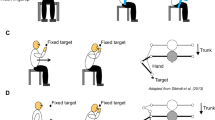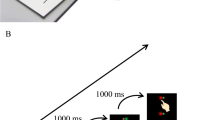Abstract
When reaching to targets within arm’s reach, intentional trunk motion must be neutralized by compensatory motion of the upper limb (UL). Advanced age has been associated with deterioration in the coordination of multi-joint UL movements. In the current study, we looked to determine if older adults also have difficulties modifying their UL movements (i.e., coordination between the shoulder and elbow joints), during a complex reaching task when trunk motion is manipulated. Two groups of healthy participants were recruited: 18 young (mean age = 24.28 ± 2.89 years old) and 18 older (mean age = 72.11 ± 2.39 years old) adults. Participants reached to a target with their eyes closed, while simultaneously moving the trunk forward. In 40% of trials, the trunk motion was unexpectedly blocked. Participants performed the task with both their dominant and non-dominant arms, and at a preferred and fast speed. All participants were able to coordinate motion at the elbow and shoulder joints in a similar manner and modify this coordination in accordance with motion at the trunk, regardless of the hand used or speed of movement. Specifically, in reaches that involved forward trunk motion (free-trunk trials), all participants demonstrated increased elbow flexion (i.e., less elbow extension) compared to blocked-trunk trials. In contrast, when trunk motion was blocked (blocked-trunk trials), all reaching movements were accompanied by increased shoulder horizontal adduction. While coordination of UL joints was similar across older and young adults, the extent of changes at the elbow and shoulder was smaller and less consistent in older adults compared to young participants, especially when trunk motion was involved. These results suggest that older adults can coordinate their UL movements based on task requirements, but that their performance is not as consistent as young adults.




Similar content being viewed by others
Data availability
The data that support the findings of this study are available from the corresponding author on request.
References
Adamovich SV, Archambault PS, Ghafouri M, Levin MF, Poizner H, Feldman AG (2001) Hand trajectory invariance in reaching movements involving the trunk. Exp Brain Res 138:288–303
Al-Senawi D, Cooke JD (1985) Matching of movements made independently by the two arms in normal humans. J Mot Behav 17:321–334
Archambault P, Pigeon P, Feldman AG, Levin MF (1999) Recruitment and sequencing of different degrees of freedom during pointing movements involving the trunk in healthy and hemiparetic subjects. Exp Brain Res 126:55–67
Bernstein N (1967) The coordination and regulation of movements. Pergamon Press, Oxford
Campbell MJ, McComas AJ, Petito F (1973) Physiological changes in ageing muscles. J Neurol Neurosurg Psychiatry 36:174–182
Contreras-Vidal JL, Teulings HL, Stelmach GE (1998) Elderly subjects are impaired in spatial coordination in fine motor control. Acta Physiol (oxf) 100(1–2):25–35
Crawford J, Vilis T (1991) Axes of eye rotation and listing’s law during rotations of the head. J Neurophysiol 65:407–423
Diggles-Buckles V (1993) Age-related slowing. In: Stelmach GE, Homberg V (eds) Sensorimotor impairment in the elderly. Kluwer Academic, Norwell
Eisen A, Entezari-Taher M, Stewart H (1996) Cortical projections to spinal motoneurons: changes with aging and amyotrophic lateral sclerosis. Neurol 46:1396–1404
Gleeson MJ, Felix H (1987) A comparative study of the effect of age on the human cochlear and vestibular neuroepithelia. Acta Otolaryngol Suppl 436:103–109
Goggin NL, Stelmach GE (1990) Age-related deficits in cognitive-motor skills. Adv Psychol 72(C):135–155
Hepple RT, Rice CL (2016) Innervation and neuromuscular control in ageing skeletal muscle. J Physiol 594:1965–1978
Jacobson GP, Newman CW (1990) The development of the Dizziness Handicap Inventory. Arch Otolaryngol Head Neck Surg 116(4):424–427
Kaminski TR, Bock C, Gentile AM (1995) The coordination between trunk and arm motion during pointing movements. Exp Brain Res 106:457–466
Kapur S, Zatsiorsky VM, Latash ML (2010) Age-related changes in the control of finger force vectors. J Appl Physiol 109:1827–1841
Khanafer S, Sveistrup H, Levin MF, Cressman E (2019) Age differences in arm-trunk coordination during trunk-assisted reaching. Exp Brain Res 237:223–236
Lashley KS (1951) The problem of serial order in behavior. In: Jeffress LA (ed) Cerebral mechanisms in behavior (the Hixon symposium). John Wiley & Sons, New York
Latash ML, Scholz JP, Schöner G (2007) Toward a new theory of motor synergies. Mot Control 11:276–308
Levin MF (1996) Inter-joint coordination during pointing movements is disrupted in spastic Hemiparesis. Brain 119:281–293
Luft AR, Skalej M, Schulz JB, Welte D, Kolb R, Burk K, Klockgether T, Voight K (1999) Patterns of age-related shrinkage in cerebellum and brainstem observed in vivo using three-dimensional MRI volumetry. Cereb Cortex 9:712–721
Ma S, Feldman AG (1995) Two functionally different synergies during arm reaching movements involving the trunk. J Neurophysiol 73:2120–2122
Michaelsen SM, Luta A, Roby-Brami A, Levin MF (2001) Effect of trunk restraint on the recovery of reaching movements in hemiparetic patients. Stroke 32(8):1875–1883
Nasreddine Z, Phillips N, Bediriam V, Charbonneau S, Whitehead V, Collin I, Cummings J, Chertkow H (2005) The Montreal cognitive assessment, MoCA: a brief screening tool for mild cognitive impairment. J Am Geriatr Soc 53(4):695–699
Newell KM, Vaillancourt DE, Sosnoff JJ (2006) Aging, complexity and motor performance: Healthy and disease states. In: Birren JE, Schaie KW (eds) Handbook of the psychology of aging, 6th edn. Elsevier, Amsterdam, pp 163–182
Oldfield RC (1971) The assessment and analysis of handedness: the Edinburgh inventory. Neuropsychololgia 9:97–113
Peinemann A, Lehner C, Conrad B, Siebner HR (2001) Age-related decrease in paired-pulse intracortical inhibition in the human primary motor cortex. Neurosci Lett 313:33–36
Pigeon P, Feldman AG (1998) Compensatory arm–trunk coordination in pointing movements is preserved in the absence of visual feedback. Brain Res 802:274–280
Poston B, Van Gemmert AW, Barduson B, Stelmach GE (2009) Movement structure in young and elderly adults during goal directed movements of the left and right arm. Brain Cogn 69:30–38
Poston B, Van Gemmert AW, Sharma S, Chakrabarti S, Zavaremi SH, Stelmach G (2013) Movement trajectory smoothness is not associated with the endpoint accuracy of rapid multi-joint arm movements in young and older adults. Acta Physiol (oxf) 143(2):157–167
Raptis H, Dannenbaum E, Paquet N, Feldman A (2007) Vestibular system may provide equivalent motor actions regardless of the number of body segments involved in the task. J Neurophysiol 97:4069–4078
Raz N, Williamson A, Gunning-Dixon F, Head D, Acker JD (2000) Neuroanatomical and cognitive correlates of adult age differences in acquisition of a perceptual-motor skill. Microsc Res Tech 51:85–93
Rossi E, Mitnitski A, Feldman AG (2002) Sequential control signals determine arm and trunk contributions to hand transport during reaching in humans. J Physiol 538:659–671
Roy E, Kalbfleisch L, Elliott D (1994) Kinematic analyses of manual asymmetries in visual aiming movements. Brain Cogn 24:289–295
Sainburg RL, Kalakanis D (2000) Differences in control of limb dynamics during dominant and nondominant arm reaching. J Neurophysiol 83(5):2661–2675
Salthouse TA (1985) Speed of behavior and its implications for cognition. In: Birren JE, Schaie KW (eds) Handboolc of the psychology of aging. Van Nostrand Reinhold, NewYork, pp 400–426
Seidler-Dobrin RD, Stelmach GE (1998) Persistence in visual feedback control by the elderly. Exp Brain Res 119(4):467–474
Seidler-Dobrin RD, Alberts JL, Stelmach GE (2002) Changes in multi-joint performance with age. Mot Control 6(1):19–31
Sibindi TM, Krasovsky T, Feldman AG, Dannenbaum E, Zeitouni A, Levin MF (2013) Arm-trunk coordination as a measure of vestibulospinal efficiency. J Vestib Res 23:237–247
Sjöbeck M, Dahlén S, Englund E (1999) Neuronal loss in the brainstem and cerebellum—part of the normal aging process? A morphometric study of the vermis cerebelli and inferior olivary nucleus. J Gerontol A Biol Sci Med Sci 54:B363–B368
Stelmach GE, Worringham CJ (1985) Sensorimotor deficits related to postural stability: implications for falling in the elderly. Clin Geriatr Med 1(3):679–694
Subramanian S, Baniña M, Sambasivan K, Haentjens K, Finestone H, Sveistrup H, Levin MF (2020) Motor-equivalent intersegmental coordination is impaired in chronic stroke. Neurorehabil Neural Repair 34(3):210–221
Thornton M, Sveistrup H (2010) Intra- and inter-rater reliability and validity of the Ottawa Sitting Scale: a new tool to characterise sitting balance in acute care patients. Disabil Rehabil 32(19):1568–1575
Tomlinson BE, Irving D (1998) The numbers of limb motor neurons in the human lumbosacral cord throughout life. J Neurol Sci 34:213–219
Tunik E, Poizner H, Levin MF, Adamovich SV, Messier J, Lamarre Y, Feldman A (2003) Arm-trunk coordination in the absence of proprioception. Exp Brain Res 153(3):343–355
Vaillancourt DE, Newell KM (2002) Changing complexity in human behavior and physiology through aging and disease. Neurobiol Aging 23:1–11
Verrel J, Lövdén M, Lindenberger U (2012) Older adults show preserved equilibrium but impaired step length control in motor-equivalent stabilization of gait. PLoS One 7(12):e52024
Voelcker-Rehage C, Stronge AJ, Alberts JL (2006) Age-related differences in working memory and force control under dual-task conditions. Neuropsychol Dev Cogn B Aging Neuropsychol Cogn 13(3–4):66–84
Walker N, Philbin DA, Fisk AD (1997) Age-related differences in movement control: adjusting submovement structure to optimize performance. J Gerontol Psychol Sci 52(2):40–52
Welford AT (1977) Motor performance. In: Birren JE, Schai KW (eds) Handbook for the psychology of aging. Van Nostrand Reinhold, New York
Welford AT (1984) Between bodily changes and performance: some possible reasons for slowing with age. Exp Aging Res 10(2):73–88
Yan JH, Thomas JR, Stelmach GE (1998) Aging and rapid aiming arm movement control. Exp Aging Res 24(2):155–168
Acknowledgements
(MFL and HS) Heart and Stroke Foundation Center for Stroke Recovery (HSFCSR PT-59562) Catalyst Grant. Elucidating the underlying mechanisms of disordered upper limb function in stroke: the relationship between deficits in trunk control and upper limb coordination. April 1, 2013–March 31, 2015. Special thanks to S.K. Subramanian for his help with the experimental set-up and to all the participants in the study.
Author information
Authors and Affiliations
Corresponding author
Ethics declarations
Conflict of interest
The authors have no conflicts to disclose.
Additional information
Communicated by Melvyn A. Goodale.
Publisher's Note
Springer Nature remains neutral with regard to jurisdictional claims in published maps and institutional affiliations.
Supplementary Information
Below is the link to the electronic supplementary material.
Rights and permissions
About this article
Cite this article
Khanafer, S., Sveistrup, H., Levin, M.F. et al. Age-related changes in upper limb coordination in a complex reaching task. Exp Brain Res 239, 2285–2294 (2021). https://doi.org/10.1007/s00221-021-06143-3
Received:
Accepted:
Published:
Issue Date:
DOI: https://doi.org/10.1007/s00221-021-06143-3




